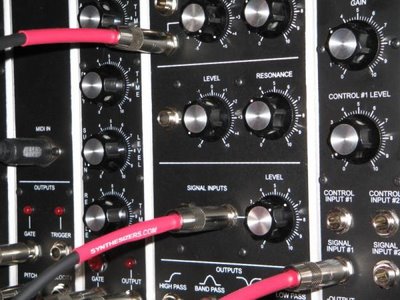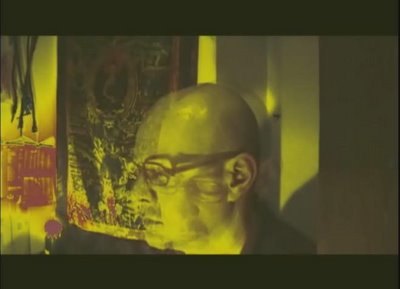
In case you missed it, the following touches on how the new Moog Little Phatty was born. Note that Axel Hartmann, designer of the user interface for many Waldorf products, the Andromeda A6 and of course the designer of the Hartmann Neuron, was involved. It's fascinating to realize that the physical design of the Little Phatty has ties to Waldorf, the A6, and the Hartmann Neuron.
"Mike talks about the conception of the Little Phatty.
I cannot think of a better transitional topic from my previous memo “Moog without Bob” to “Little Phatty”; Bob’s last project. He was very excited about the possibilities of this keyboard from our earliest discussions. I believe he felt that the technology and the team that we had (have) in place would finally enable him to bring a synth to thousands of musicians who were previously in no financial position to enjoy a Moog synth. I am very proud to say that is exactly what we are about to accomplish with the release of the Little Phatty.
As a starter, let me give you a bit of history about the development of the project. I am not exactly sure when the concept first entered Bob’s mind but I do have notes on it from early 2004 when we had a product planning meeting and Turnkey requested us to give this some consideration but I am sure he had thought about of it long before that. Then during the Summer of 2004 Steve and Bob really began the serious work of technical conception which resulted in Steve writing the initial technical spec in August, 2004. From there my memory gets a little fuzzy because 2005 was such a difficult year. What I do remember is that we sent off our first ideas to Axel Hartmann around October of 2004 and we met with him at the NAMM Show in 2005. (Axel Hartmann and his Design Box industrial design associates have been a long time collaborators of the company.) At NAMM and then subsequently at last year’s Messe, the first concepts of this keyboard began to take shape.
From there, Cyril Lance came on board. While he did not have the time he wanted with Bob, Cyril is an extremely talented engineer in his own right. This will be evident to those who discover the Little Phatty. The project team that worked on this design has come from the far corners of the world – Asheville, North Carolina where Moog is headquartered; Germany where Design Box is located; software from our consultants in California; and importantly our Chinese partners. Yes, our Chinese partners. No, we are not making this keyboard in China. It still will be made right along side the Voyager in Asheville but without the component level support from our Chinese partner we could never reached the low price point of this product.
So what about the name, Little Phatty? Taking a cue from Bob’s choice of the name “moogerfooger” for our line of effects modules, we adopted the moniker “Little Phatty” for our new synth because of its irreverent; tongue-in-cheek nature. At first it was just funny, but it grew on us as the personality of the synth developed. The Little Phatty name is a description of what we wanted this synth to be: smaller, less imposing, a chip off the old block as far as the sound character, and a price point people have a chance of reaching. It is a true Moog synth. It sounds really fat and ballsy. In this way we feel the name echoes the “minimoog”. Bob liked the name Little Phatty. He had a great sense of humor about these things. I know if he were still here we would be enjoying some great laughs, and I think he would really love the way the LP sounds. It definitely contains the sound that he created.
So that’s it. We hope you will buy one, enjoy it, and drop us a note about your experiences with this or any other Moog product.
As always, we appreciate every single one of you.
Warm Regards,
Mike Adams"



 "Essentially, the mandala detects where and how hard you hit it and translates that information into sound and sound controllers for your playing pleasure and exploration. " The mandala comes with it's own brain drum containing sounds and it can be used as a MIDI controller for other gear as well. Via meeglosh in the comments of this post.
"Essentially, the mandala detects where and how hard you hit it and translates that information into sound and sound controllers for your playing pleasure and exploration. " The mandala comes with it's own brain drum containing sounds and it can be used as a MIDI controller for other gear as well. Via meeglosh in the comments of this post.
 In case you missed it, the following touches on how the new Moog Little Phatty was born. Note that Axel Hartmann, designer of the user interface for many Waldorf products, the Andromeda A6 and of course the designer of the Hartmann Neuron, was involved. It's fascinating to realize that the physical design of the Little Phatty has ties to Waldorf, the A6, and the Hartmann Neuron.
In case you missed it, the following touches on how the new Moog Little Phatty was born. Note that Axel Hartmann, designer of the user interface for many Waldorf products, the Andromeda A6 and of course the designer of the Hartmann Neuron, was involved. It's fascinating to realize that the physical design of the Little Phatty has ties to Waldorf, the A6, and the Hartmann Neuron.
 Title link takes you there. This is the equivalent of the Analogue Haven booth at NAMM. Can't tell if it's actually live or not, but there is some webcam action going on.
Title link takes you there. This is the equivalent of the Analogue Haven booth at NAMM. Can't tell if it's actually live or not, but there is some webcam action going on.
 Roland JP8000 and Korg Z1 drones. Zengomi posted the video on the-gas-station. Title link takes you to a 10M WMV. There is a 60M version in the post.
Roland JP8000 and Korg Z1 drones. Zengomi posted the video on the-gas-station. Title link takes you to a 10M WMV. There is a 60M version in the post.











